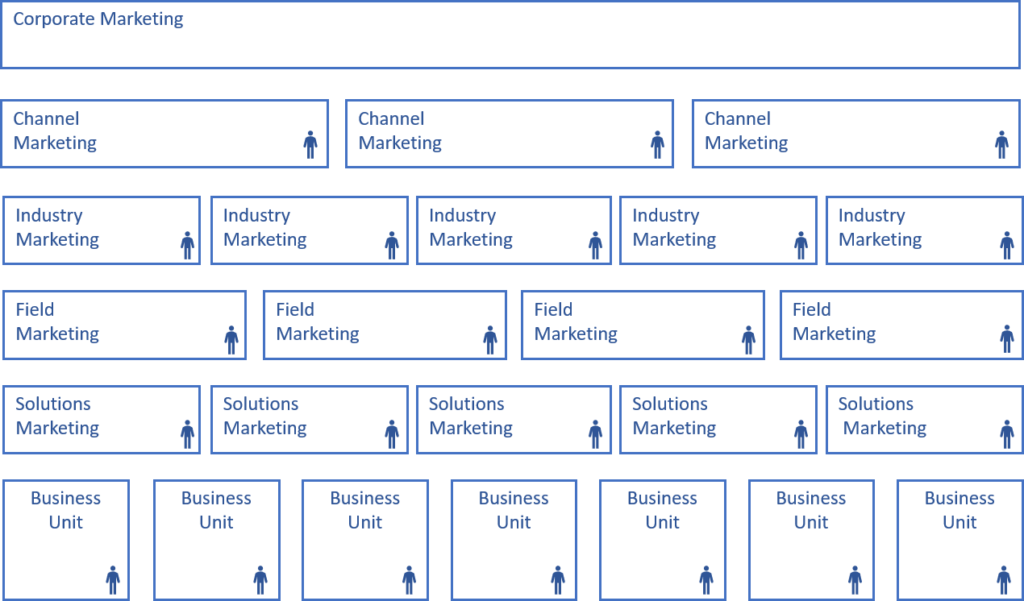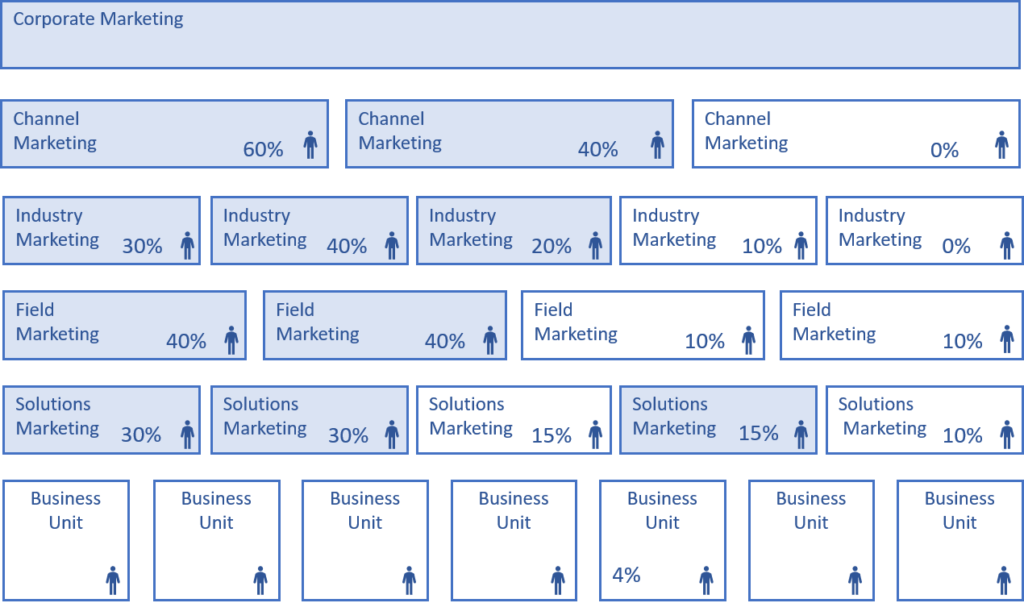Getting Mindshare and Campaign Air Cover for Product Marketers in Larger Companies
One of the challenges for Product Marketers in much larger organizations is their respective portfolios getting the market air cover they need through campaigns and other efforts.
In this blog post, I’m going to focus on how to get more mindshare across the various marketing teams for your efforts. Note: This is just one facet of the overall effort a Product Marketer in a large organization needs to focus on. For example, I won’t talk about seller engagement here.
Larger organizations and their respective marketing team or teams can have a diverse set of priorities which makes an individual Product Marketer’s need more challenging to take center stage or at least command a significant amount of resources for targeting and reaching their audiences through the various marketing channels. This gets more pronounced the larger the organization is and the more extensive their suite of offerings or suite of portfolios.
I’m sure this can frustrate a Product Marketer who is intensely focused on supporting and growing their portfolio. Especially if that Product Marketer comes from a much smaller organization where there was more direct influence in larger-scale campaigns.
Imagine in the graphic below that the organization has one or more Product Marketers embedded in each business unit. In fact, that business unit likely has a broader Marketing team supporting it that either reports directly into the Business Unit’s leadership or as a dotted line relationship to that leader as well as rolls up into a larger Marketing organization.

Then imagine that you, as a Product Marketer, have to do everything you can think of to grow your portfolio. How do you do that when the organization looks as layered and as complex as the one above, when competing priorities make your portfolio just one smaller aspect of what other marketers are focused on?
Ultimately, though, the Product Marketer needs to realize that their priorities aren’t always or are even rarely going to bubble to the top and take center stage when it comes to large organizations.
However, that doesn’t mean there isn’t an opportunity to change that dynamic a few points in your favor.
Let’s use the modified graphic below, as an example. Imagine that you and your portfolio fall into the business unit that contributes to 4% of the entire company’s total revenue. Right off the bat, you’re thinking, “Wow, we’re such a small piece of the company’s revenue.” Let’s assume the business unit has been around for quite some time.

Just for explanation, when we look at the percentages across the Business Unit layer, these percentages represent each unit’s contribution toward total revenue for the company. When we look at the percentages for each layer above that, these percentages represent what each box touches in terms of total revenue as a result of that layer. For example, let’s assume that the business units combined generate $10 Bn in revenue for the company overall. You can see that your business unit then contributes $400 Million of that number. However, the Solutions Market layer is involved in successfully generating $3 Bn combined which means that that first Solutions Marketing team touches $750 Million of that. This is because the company makes it money through a number of channels.
Another example would be to imagine that the company sells direct and through three major channels (Channel layer). Let’s say direct represents 50% and channels represent 50%. That would mean the Channel Marketing layer touches $5 Billion to the company’s performance.
Now, you might be thinking there, “Wait, isn’t there overlap.” That’s correct. Think of it this way through another eample. The various Solutions Marketing teams are responsible for marketing broader solutions of offerings from across business units. However, they also market – working closely with their Channel counterparts – through the Channel layer. If they were selling these solutions directly, they are also working with their Field Marketing counterparts to do that.
In some sense, the upper layers to some degree, represent what I call translation engines. They are translating core positioning and messaging information from the business unit into positioning and messaging that will resonate more with the audiences the upper layers represent for the greatest impact.
And put another way, it’s a larger-scale team sport in very large organizations. No one person can drive growth in their portfolio without close collaboration with other parts of Marketing. And though this is true for every organization small or large with at least two marketers, it’s highly complex in large organizations.
Now, let’s get back to you as the Product Marketer who is tasked with growing the portfolio’s revenue when that revenue makes up 4% of $400 Million of the company’s total revenue.
How do you ensure that the attention the rest of the company pays to your business unit is more than it deserves if just looking through the lens of which business unit deserves more attention?
Amplify Your Message Internally
You want to focus on amplifying your message internally, as much as possible. Now, let’s take that graphic further. We’ve done two things in the graphic below.

- The percentages now represent how your business unit’s revenue contribution of 4% is touched across the various layers. We’re basically understanding more about the various routes-to-market and what teams are involved from a marketing standpoint.
- The second thing we’ve done is highlight areas of priority for the Product Marketer. Because time is finite and the Product Marketer has to prioritize, the idea is to prioritize the places that contribute most to revenue for your portfolio.
- Solutions Marketing – The Product Marketer has identified three teams to place priority for in terms of engagement.
- Field Marketing – The Product Marketer has decided to focus on two teams.
- Industry Marketing – The Product Marketer has decided to focus just on three industries and related teams.
- Channel Marketing – Because there are only two primary channel routes-to-market, they feel compelled to focus on both.
It goes without saying that the Product Marketer is applying some pretty sound logic to where they spend their time and why. My observation is that many Product Marketers don’t often apply a rationale like this or other deliberate method in terms of where they choose to spend their time. And if you think that other Marketing teams will at times be asking for things, it will be very easy for the Product Marketer to get caught up spending a disproportionate amount of time in activities that contribute very little to the success of their offering.
Ironically, you want the above to be the case if you want to move the needle for your organization. Because if everyone was methodical like this, you can see that the attention your portfolio gets would also be at 4% of total mindshare at all times. We’re playing the system to get more attention.
Now, that might sound counterproductive to the rest of the organization. But it’s not. The fact is that the organization needs people to be doing this so that at times, even the business units with a small minority stake get heard and can have a much larger voice at times. And if the Product Marketer isn’t taking steps to amplify internally, the business unit stands a chance of never getting their small but booming voice heard when it needs to.
Think of it this way. Imagine your small business of 4% represents one of the company’s strategic areas for long-term growth. There will certainly be pressures from the other business units to use up mindshare internally and externally at the expense of this small business unit. However, top leadership also needs this small business to get its day in the sun periodically. The Product Marketer, indirectly and from way down in the organization, has a role to play to make this happen.
And as the Product Marketer, don’t also discount that even if the business contribute 4% to the business’ revenue, it’s important for the business entirely to have it contributing and not be a breakeven business or even a business that drains on the rest of the organization.
How to Get Your Portfolio More Mindshare
We’ve shared some ideas as to how to gain more mindshare across the layers and teams below. Just like with the prioritizations captured above, you’ll also need to prioritize what you are able to do. You don’t want to create a situation where you overextend yourself even beyond what you are capable of.
- Be deliberate in all of your choices, activities and actions.
- Become intimately familiar with all facets of your portfolio in terms of industry usage, segment usage, buyer personas, and how your portfolio can be plugged into broader solutioning.
- Become intimately familiar with routes-to-market that best serve your portfolio. For instance, are there particular channel partners that are responsible for a sizable portion of revenue?
- Be prolific in terms of internal education content that helps marketers across the various layers understand more about your offering, how it helps their respective target audiences, fits into broader solutions, and how it serves organizations within industries. Consider doing this on internal knowledge boards or even in an internal blog.
- Get to know the various existing and planned campaigns and initiatives across the various layers to see where you can actively plug in your portfolio.
- Add links to your latest content in your email signature for when emailing internally.
- Be active in regularly meeting with marketers across the layers where there is an opportunity for them to help you amplify your message.
- Create a newsletter or similar regular communication for your counterparts on your portfolio, the value it brings across the layers and includes educational content as well.
- Use different formats to communicate your message including simple consumable podcasts and video content.
- Keep a roadmap up-to-date and communicate that regularly to your counterparts across the other layers. If they know what you have coming and you readily share that, they may take that into advisement for how they craft their own efforts in the future.
- Make sure any collateral content is available across all internal knowledge bases available.
- Be focused on what matters for your colleagues and to their targeted audiences when conveying positioning and messaging. For example, create messaging that specifically talks to the respective market segments, personas, industries and buyers that make it easy for your counterparts to understand your portfolio’s value within their own areas of focus.
- Drive thought leadership creation for your business unit that can be shared both across your organization as well as upward across the organization.
- Make sure business unit leadership is sharing thought leadership for your portfolio across their own internal and external (ex. Social media) channels for greater visibility.
- Be helpful. Be willing to give to your colleagues across the layers where you can. If you make it easy, effective and beneficial to work with you, don’t be surprised if they give you more attention in the future.
- Ask to participate in meetings your colleagues have that might be beneficial to participate and contribute to.
- Originate creative ideas for your colleagues in the other layers during meetings. Show them you are thinking about their respective areas and are a good resource for ideas and brainstorming related to new campaigns and other activities.
- Use proven approaches in terms of templates, frameworks and other tools for capturing positioning, messaging and information on your portfolio. Be consistent in your use of these and be sure the templates and tools you use represent a best practice to the organization.
- Follow through on your commitments, especially when lending your help to a counterpart.
- If resources allow and you can get initial buy-in and budget, construct simple campaigns-in-a-box whereby you have a small collection of readily usable thought leadership that can be leveraged by one or more of the layers.
- Train yourself up in Adobe InDesign, design, podcast and simple video editing apps so you can create and modify internal-facing content. Large organizations very likely have a team responsible for developing polished assets from content. The idea is not to get professional grade because these efforts are focused on internal audiences. However, the savvy Product Marketer in a large organization may find using their own talents for internal-facing content as a way to have more impact without incurring relating budget costs and headaches.
Now, this may seem like a lot of work. It is. But if you want to move the needle to your advantage in a large organization with many layers, marketers and priorities, this is how you build your influence across the organization. And in doing so, don’t be surprised that others across the organizations see you as someone whose portfolio and you are worth of promotion.
As a Product Marketer, David has successfully launched products, services, solutions and platforms across a number of disciplines in the technology industry. David’s passion for Product Marketing and his eye for seeing how Product Marketing can lead to even stronger business outcomes led him to bring his expertise and knowledge to Shoot the Curl Marketing.



